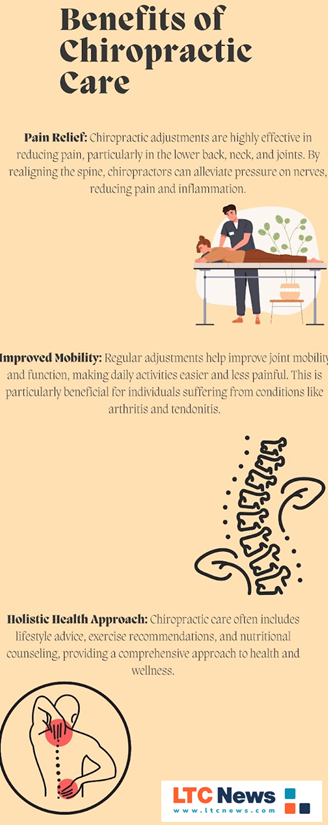Chiropractic Care: Growing Option for Seniors in the U.K. and Worldwide

If you’re over 45, you’ve probably thought about how to stay active and avoid the aches and limitations that come with aging. Back pain, joint stiffness, and mobility issues aren’t just discomforts — they’re early signs that independence could be at risk. For many, the fear isn’t just about pain, but about what comes next: needing long-term care before you’re ready.
That’s where chiropractic care comes in. Once dismissed as an alternative treatment, it’s now part of a global shift toward drug-free, regulated, and patient-centered care for older adults.
Advances in Chiropractic Care: U.S., U.K., and Beyond
Around the world, chiropractic is being embraced as a mainstream tool for senior health:
- United States: With more than 70,000 licensed chiropractors, the U.S. has the largest professional base. Medicare covers limited chiropractic services, underscoring its acceptance. Research from the National Institutes of Health shows chiropractic may reduce dependence on opioids for chronic pain — a major issue among seniors.
- United Kingdom: In the U.K., chiropractic care is closely regulated. Every chiropractor must be registered with the General Chiropractic Council (GCC), which sets strict standards for training and practice. For you, that means peace of mind — care that’s designed to be safe, credible, and adapted to the needs of aging bones and joints.
- Canada and Australia: Older adults are now one of the fastest-growing groups turning to chiropractic care. In many places, chiropractors work side by side with GPs and physiotherapists, making it a natural part of the wider health system rather than something separate.
- Europe: In countries like Denmark and Switzerland, chiropractic is built right into the public health system. That means seniors don’t have to choose one type of care over another — chiropractors and medical doctors often work together, giving older adults more complete support.
Wherever you look, the pattern is the same — chiropractic has moved far beyond the fringe. It’s now recognized as a real way to help older adults stay independent and protect their quality of life. In the U.K., where the population is aging rapidly, that shift is even easier to see.
Chiropractors Across the U.K.
In the U.K., chiropractic care has become both regulated and widely available. Every chiropractor must be registered with the General Chiropractic Council, which requires years of training — usually a master’s degree — and ongoing professional oversight.
Rob Finch, CEO of the Royal College of Chiropractors, has stressed that patient safety must remain central.
Our profession learns from every case to ensure that chiropractic remains a safe and trusted part of patient care.
It’s no longer something you’ll only find in London or the bigger cities. Clinics have opened in towns and regional centers across the country, making it much easier for older adults to find help close to home.
Among these many practices, Ocean Chiro in Plymouth exemplifies the type of community-based service that provides personalized care while reflecting the broader national trend.
For you, that means chiropractic isn’t a niche option anymore. It’s part of the wider set of choices that can help you stay independent as you age.
Physiotherapist Jack Chew, host of the Physio Matters Podcast, recommends doing research before selecting a chiropractor.
There are plenty of good chiropractors out there, but you need to check credentials and ask questions before opting for treatment.
How Chiropractic Care Helps Seniors Stay Independent
- Fact: Chiropractic care can play a meaningful role in helping you remain mobile and independent as you age.
Here’s what it offers:
- Mobility and flexibility — Gentle adjustments and soft-tissue therapy reduce stiffness and expand the range of motion in the spine, hips, and shoulders.
- Pain reduction without drugs — If you take multiple prescriptions, adding painkillers increases your risk of side effects. Chiropractic provides a drug-free alternative.
- Balance and fall prevention — By improving spinal alignment and neuromuscular control, chiropractic may reduce fall risk, one of the biggest threats to senior independence.
- Timely, person-centered care — The British Chiropractic Association emphasizes early, individualized treatment to prevent long-term decline.
Chiropractic works best when combined with exercise, preventive screenings, and other healthy-aging strategies.

Myths and Facts About Chiropractic Care
Myth: Chiropractic is unsafe for older adults.
Fact: When a qualified professional does it, chiropractic care is generally very safe. In the U.K., every chiropractor has to meet the strict training and registration standards set by the GCC. For older adults, treatments are always adapted — using gentler techniques like low-force adjustments, drop tables, or handheld instruments designed to work with aging joints and bones.
Myth: Complications are common.
Fact: The most frequent side effects are mild, such as soreness or fatigue, resolving within days. Serious complications are rare but highlight the importance of proper screening. The NHS and NICE recognize manual therapies, including chiropractic, as effective for chronic low back pain when combined with exercise.
Myth: Chiropractic is only for back pain.
Fact: Chiropractors treat neck pain, headaches, joint stiffness, posture issues, and even mobility or balance problems.
Myth: Chiropractic lacks scientific credibility.
Fact: In the U.K., the profession is regulated by law. Practitioners undergo accredited university training and are held accountable by the GCC.
Practical Advice if You’re Considering Chiropractic
If you’re thinking about chiropractic as part of your aging-in-place plan:
- Check credentials — Make sure your chiropractor is registered with the GCC in the U.K. or licensed in your country.
- Ask about senior-friendly methods — Low-force techniques and gentle mobilizations are often safer than aggressive manipulations.
- Share your health history — Conditions like osteoporosis or arthritis need to be considered before treatment.
- Start gradually — Begin with a few sessions and monitor how your body responds.
- Reassess regularly — Look for signs of improvement in sleep, walking, or reduced reliance on medication.
Maintaining Quality of Life
For adults 45 and older, chiropractic care is more than back pain relief. It’s a regulated, evidence-based approach to help you stay mobile, independent, and in control of your health. While myths about safety or pseudoscience still exist, global advances and strong regulation — especially in the U.K. — have made chiropractic a credible option for seniors.
As you plan for aging, consider how chiropractic, exercise, and long-term care strategies fit together.


